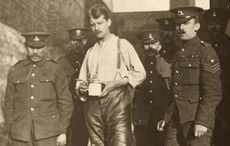One of the most asked questions of American Civil War enthusiasts across the States is ‘Who was the first casualty?’ The answer, that ‘it was a Private Daniel Hough from some unknown part of Co Tipperary in Ireland,’ usually comes as a surprise to many.
Although he has long been forgotten in his native land and information on him in the States has always been sketchy, what is known is that after emigrating to the New World in 1849, Hough enlisted in the US Army some months later and was posted at Fort Sumter in Charleston Harbour, South Carolina in April 1861 when the war broke out. Although he was one of the US army that was forced to surrender after fighting unsuccessfully to defend the fort from Confederate attack, it wasn’t the latter who killed him. In fact he was killed by accident soon after in a surrender ceremony.
A radio documentary due to be aired in Ireland this weekend has for the first time attempted to investigate the background of Private Daniel Hough by researching his story both in Ireland and the US. Featuring interviews with contributors from both countries, it incorporates sources such as famine ship passenger lists, Hough’s military record, and Tipperary parish records in order to ascertain from where within the county he originated from.
According to Nora O’Meara from The North Tipperary Genealogy Centre in Nenagh, Co Tipperary, “the majority of people once they left Ireland rarely put down the exact parish they were from, they normally said the county i.e. Tipperary. They didn’t even differentiate between north and south Tipperary.”
Newspaper archives from the 1860s are also accessed, as is the US federal census in order to trace a possible brother he had by the name of William who lived in New York. The programme traces Hough’s time in Ireland through to the details of his unfortunate death in 1861.
To this day, the precise location of Hough’s final resting place in America is a source of much debate and mystery. National Parks Service Historian at the Fort Sumter National Monument Richard Hatcher is interviewed on the parade ground at Fort Sumter where documentation indicates that he was initially buried but others including George Hough Gundy from Charleston, who has conducted his own research, believes it’s possible that Hough’s body was later exhumed and taken to New York at the request of his family. A recurring theme throughout the documentary is how notoriously difficult it is to conduct research on Daniel Hough - largely because of his surname. How it was pronounced and spelled on documents once he left Ireland varies greatly.
According to Irish military historian Wesley Bourke, one reason for this was because many Americans who Irish emigrants came into contact with once they got off the boat in the 1850s ‘spelled their names phonetically’ and they were unable to correct them due to high levels of illiteracy. Therefore as a result Daniel’s surname was spelt as ‘Howe’ and ‘Haugh’ on occasion.
Others interviewed from Charleston include John Tucker - assistant director of the South Carolina Historical Society, James Lyles – superintendent of St Laurence Cemetery, John Brumgardt - director of the Charleston Museum, Carl Borick - assistant director of the Charleston Museum and June Murray Wells – director of the Confederate Museum.
The revealing documentary entitled ‘What the Hough - The First Casualty of the American Civil War was a Tipperary Soldier’ is produced, presented and researched by Tom Hurley and was made with the support of the Broadcasting Authority of Ireland & Tipp FM. It will be aired on Tipp FM radio in Ireland on Sunday next October 7th at 6 pm (Irish Time) but can be heard in the US on www.tippfm.com or as a podcast.
(Tom Hurley is a producer at Tipp FM Radio in Ireland.)




Comments